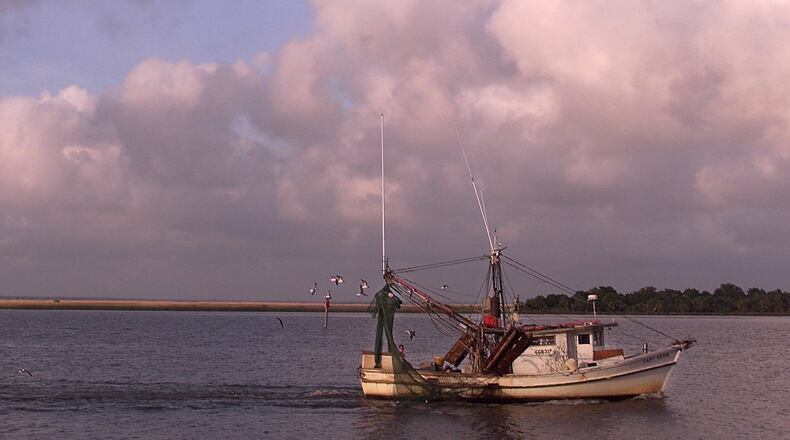Georgia scored a major victory Thursday as the U.S. Supreme Court ruled unanimously for Georgia in its long-running dispute with Florida over water that focuses on Georgia’s use of the Chattahoochee River.
The court, an opinion by Justice Amy Coney Barrett, dismissed Florida’s case, saying Florida had failed to prove that Georgia water use caused the collapse of Florida oyster fisheries downstream in Apalachicola Bay. READ THE FULL STORY.
About the case
Supreme Court justices heard Florida’s water rights case against Georgia on Monday, Feb. 22, 2021, an important hour-long event that could mark the beginning of the end of an expensive lawsuit that’s stretched over eight years.
The oral arguments, held online due to the pandemic, marked the second time justices had examined the case in four years. Here’s a primer on what’s happened so far and what’s at stake.
LISTEN ON DEMAND: Audio from the Supreme Court oral arguments in Florida v. Georgia, a case on water rights law from February 2021
WHAT ARE FLORIDA AND GEORGIA FIGHTING OVER?
Water from the Apalachicola-Chattahoochee-Flint river basin. The ACF originates northeast of Lake Lanier and cuts across southwest Georgia farmland, flowing along the Alabama border into the Gulf of Mexico through Florida’s Panhandle.
The basin serves as the main source of drinking water to more than 4 million people in metro Atlanta, including roughly 70%. of the region’s population. It also supports a broad swath of industries, including agriculture, power generation, manufacturing, commercial fishing and recreation.
Georgia, Florida and Alabama have been fighting over water in the ACF for more than three decades.
Credit: Blake Guthrie
Credit: Blake Guthrie
WHAT’S THIS SUIT ABOUT?
Florida sued Georgia over its behavior during a multi-year drought, which Florida alleges led to the ecological collapse of the Apalachicola Bay in 2013 and its iconic oyster industry, which once produced 10% of the country’s oysters. The mollusks rely on a delicate balance of freshwater from the ACF and saltwater from the Gulf of Mexico to survive. When freshwater flows from the ACF decreased, the bay’s salinity increased, which allowed oysters’ predators to thrive and disease bacteria to proliferate.
Florida blames Georgia for the using up too much water upstream, particularly farmers in southwest Georgia.
Florida is asking the Supreme Court to impose water usage limits on Georgia, particularly during drought years, so more freshwater from the ACF can flow to Apalachicola.
WHAT’S GEORGIA SAYING?
That its water use has been reasonable and that Florida’s oyster industry has been hurt by climate change, Florida’s lax fishing oversight and the Deepwater Horizon oil spill.
Georgia warns that, if Florida gets its way, farmers won’t be able to irrigate land in the highly productive, ag-heavy region around the Flint. It estimates that the cost to Georgia would be “severe,” between $335 million to more than $1 billion.
Georgia also contends that limiting its residents’ consumption still won’t get Florida the water it wants, due to the complicated way the federal Army Corps of Engineers regulates its locks and dams in the ACF river basin.
WHAT ABOUT ALABAMA?
Alabama is sitting out of this particular fight but is backing Florida. since it, too, sits downstream from Georgia. Alabama is party to two separate cases that have been filed against the corps that are working their way through lower courts that could impact Georgia.
WHAT HAPPENED LAST TIME?
Supreme Court justices first heard oral arguments in this case in Jan. 2018. Justices opted to reject an earlier recommendation from a court-appointed expert judge to dismiss Florida’s suit. Instead, in a 5-4 decision, the court assigned another expert judge, Paul Kelly of New Mexico, to revisit the case and see if he could find a remedy that would help Florida without decimating Georgia’s economy.
Kelly determined that Georgia’s water use is “reasonable” and urged justices to reject Florida’s case.
WHAT ELSE HAS HAPPENED SINCE?
The Supreme Court has two new members — Brett Kavanaugh and Amy Coney Barrett —since it last heard the case. Some observers believe that, because the two Trump picks are conservative, they’d be more receptive to Georgia’s argument that a water consumption cap would ravage the state economy, though water law is less of a partisan issue than a regional one.
Meanwhile, Florida fish and wildlife officials in July took the extraordinary step of ordering a five-year oyster harvesting ban in the Apalachicola Bay to help the population rebound.
HOW MUCH HAS THE LITIGATION COST?
The Supreme Court case has cost Georgia taxpayers more than $49 million in legal fees, according to the attorney general’s office. It’s cost Florida even more. And that’s not counting the separate but related suits currently moving through lower courts.
Credit: HYOSUB SHIN / AJC
Credit: HYOSUB SHIN / AJC
WHY IS THIS IMPORTANT?
It’s not just about Apalachicola oysters. The Bay is a unique hotspot for biodiversity, and oyster harvesting has for generations been at the heart of the region’s economy and culture.
For Georgia, the case represents not only an existential threat to the future growth of metro Atlanta, but could have major economic implications for agriculture, the state’s largest industry.
The case is expected to set a legal precedent for water fights on the East Coast. Such suits are expected to become even more frequent as climate change threatens to trigger more extreme weather and droughts in the decades to come.
WHEN WILL THIS BE OVER?
Not anytime soon. Best case scenario for Georgia is the case gets dismissed this summer. Even if it does, there are still several lower-level suits challenging the corps’ operations in the ACF and the neighboring Alabama-Coosa-Tallapoosa river basin that could impact Georgia water.
If Florida wins a favorable ruling from the Supreme Court, the case could be sent to another expert judge to determine how ACF water should be divvied between Georgia and Florida, which would stretch the timeline even longer.
About the Author
Keep Reading
The Latest
Featured



